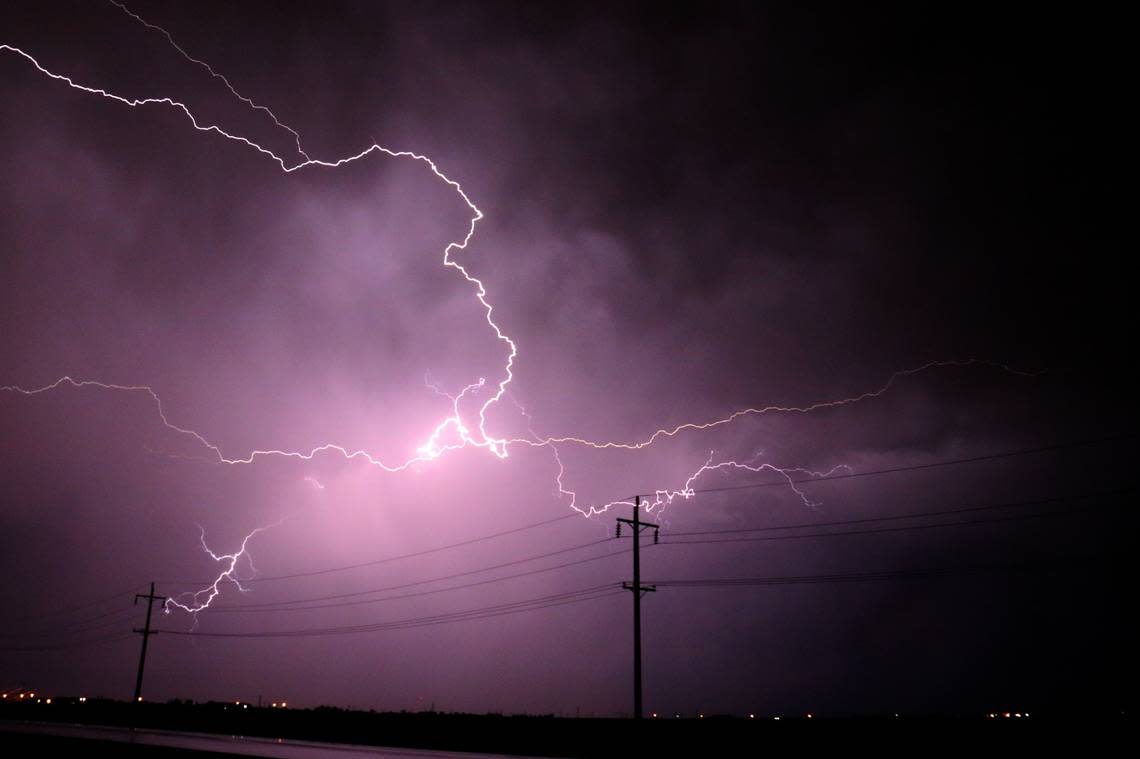Marble-sized hail expected with thunderstorms to hit North Texas Thursday

The National Weather Service issued a weather alert at 8:37 a.m. on Thursday, warning residents of strong thunderstorms until 9:15 a.m. The alert is for Montague, Cooke, Jack, Wise, Stephens, Palo Pinto and Parker counties.
Expect marble-sized hail (0.5 inches) and wind gusts of up to 30 mph.
"At 8:36 a.m., Doppler radar tracked strong thunderstorms along a line extending from near Terral to 6 miles east of Jacksboro to near Caddo. Movement was east at 30 mph," says the NWS. "Gusty winds could knock down tree limbs and blow around unsecured objects. Minor damage to outdoor objects is possible."
Expect strong thunderstorms in the following locations:
• Bowie, Nocona, Graford, Lake Bridgeport, and Lake Amon G Carter around 8:40 a.m.
• Palo Pinto around 8:45 a.m.
• Chico, Lake Nocona, and Sunset around 8:50 a.m.
• Bridgeport around 8:55 a.m.
• Mineral Wells, Alvord, and Lake Palo Pinto around 9 a.m.
This includes Interstate 20 between mile markers 387 and 406.
Other impacted locations include Adell, Cundiff, Rosston, Cottondale, Dennis, Bulcher, Park Springs, Capps Corner, Crafton and Nocona Hills.
According to the NWS, "If outdoors, consider seeking shelter inside a building."
This alert is in effect until 9:15 a.m.
Actions to take when lightning threat is imminent
Lightning strikes the United States about 25 million times a year. Most of the strikes occur in the summer, killing 20 people each year, according to the NWS. Chance of lightning increases as a thunderstorm approaches and peaks when the storm is overhead. It diminishes as the storm moves away.
Here are tips on how to stay safe during a thunderstorm:
• To lower the risk of lightning strikes, when going outdoors, develop a plan to reach a safer spot.
• If the sky grows ominous and you hear thunder, seek out a safe place to take shelter.
• Once indoors, avoid touching corded phones, electrical equipment, plumbing, and windows and doors.
• Wait for 30 minutes after the last lightning or thunder before going back out.
If finding indoor shelter is not an option:
• Avoid open fields, hill peaks, or ridge tops.
• Keep a distance from tall, isolated trees or other elevated objects. If in a forest, stay close to lower trees.
• When in a group, space out to prevent the current from transferring between individuals.
• When camping in an open environment, select a campsite in a valley, ravine, or low region. Just remember, tents do not offer protection from lightning.
• Do not approach water, wet objects, or metal items. Although water and metal do not attract lightning, they conduct electricity effectively.
What steps to follow when driving in the rain?
• Switch on headlights — Even during daylight hours, using headlights can enhance visibility and signal your presence to other drivers.
• While driving — Stick to the middle lanes and stay on elevated ground. Rainwater tends to accumulate at the road edges.
• Steer clear of puddles — Driving into puddles or low areas of rainwater can cause vehicles to hydroplane or skid out of control.
• Don't tail large vehicles closely — Trucks or buses can kick up a water spray that obstructs visibility.
• Steer clear of flooded areas — When coming to a flooded road, turn around and head back. Flash flooding currents are strong and can sweep drivers off roadways. Driving through deep water can also affect a vehicle’s mechanical and electrical systems.
What is hydroplaning?
Hydroplaning is when a vehicle starts uncontrollably sliding on wet roads.
This happens when water in front of the tire builds up faster than the vehicle’s weight can push water out of the way. The water pressure then causes the vehicle to rise and slide on a thin layer of water between the tires and the road, making the driver lose control. Hydroplaning is primarily caused by three factors:
1. Vehicle speed — When a vehicle’s speed increases, the tire-traction grip and ability to control the vehicle decreases. Drive at a reduced speed during wet weather.
2. Water depth — The deeper the water, the sooner a vehicle loses traction on the road. It doesn’t matter how deep the water is, even a thin layer can lead to hydroplaning.
3. Tire tread depth — Checking your tire tread before hitting the road is important, as low or no tread can lead to sliding.
In the event of your vehicle hydroplaning, here’s what to know:
• Ease off the accelerator — Step off the gas to slow down the vehicle until the tires find traction.
• Turn into the skid — Turning into the skid can help the vehicle’s tires realign to regain control.
• Make sure the tires reconnect with the road — During the skid, wait until the tires reconnect with the road and then gently straighten the wheels to regain control.
• Brake gently as needed — Brake normally if the vehicle has anti-lock brakes and pump brakes gently if in an older vehicle.
Source: The National Weather Service


